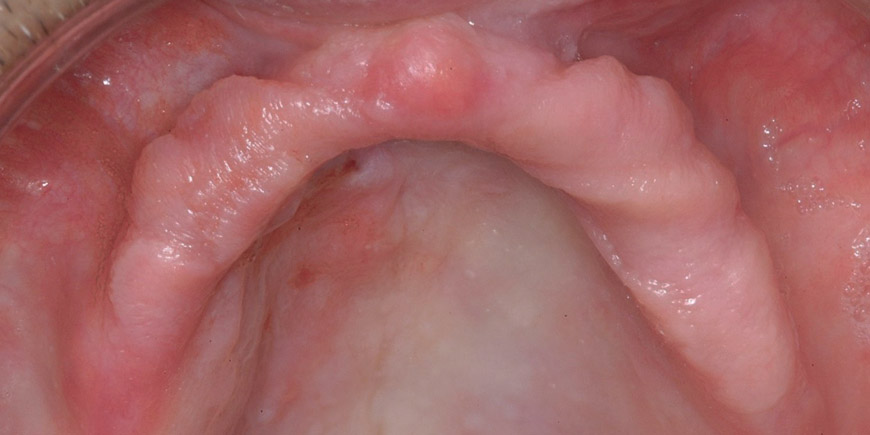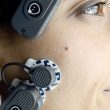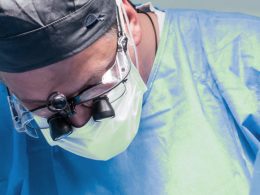Table of Contents
Many patients, unfortunately, lose all or almost all of their teeth throughout life. Dental cavities, periodontal diseases and trauma; are usually the most frequent causes of this sad reality.
Worst of all, is that a large part of these patients cannot or do not care to replace, as soon as possible, the lost dental organs. Most likely because they think they can do it at any time in their life, without knowing that as time passes, the jaws are reabsorbed; to the point of losing almost all its bone mass at the alveolar level.
So, it is very likely that when these people decide to solve the matter, their Dentists will tell them to forget about implants and fixed prostheses, simply because they do not have enough bone for it, that there is no bone to place implants.
And the surest thing is that it is true, that the patient has his jaw so atrophied, that even with bone grafts it is not possible to perform the procedure. At this point, there are only two alternatives: resigning to the perennial use of a removable denture or opting for advanced surgical techniques of oral rehabilitation.
But the big question that many people ask is if in reality exist special dental implants for these cases, for patients with little or no bone.
And the answer is yes, they do exist, and for more than 25 years!
What Are These Implants Special About?
Basically in its design, length and anchor site. They are implants much longer than conventional dental implants (4 or 5 times), they are conceived under special manufacturing standards and are designed to be placed in other facial bones; different from the maxillary bones.
If the jaw no longer serves us, we move from it and anchor the implants to other bones of the face.
Zygomatic Implants, as their name implies, are anchored in the malar or zygomatic bone (which forms the cheekbone), where the bone tissue is much denser than that of the upper jaw.
This solid structure to support the implants, offers greater retention and distributes functional loads over a larger surface area, allowing immediate and successful placement of dental prostheses on the same day of surgery; or 2 or 3 days after it.
Origin of Zygomatic Implants
Zygomatic Implants were conceived to rehabilitate patients who, either due to oncological pathology or traumatic experience, had lost part of their upper jawbone, and it was only possible “to anchor” an implant to another anatomical structure. It was the beginning of the 90s and no one imagined that these implants would one day be placed in conventional patients, that is, with no oncological, traumatic or congenital history.
It was not until the beginning of the 21st century when cases of Zygomatic Implants began to be reported in totally edentulous patients in the upper arch with severe bone atrophy, obtaining very promising results. So much so, that in just 2 or 3 years their use spread worldwide and they became part of routine interventions in Maxillofacial Surgery.
What Are Their Advantages?
In cases of severe maxillary atrophy, a lot! Let us see below the 4 main reasons why long implants are an ideal alternative and far superior to other surgical techniques in these types of patients:
- Bone Grafts Are Not Necessary As they are anchored in the internal part of the cheekbones, with these implants it is not necessary to use the jawbone for their placement.
- Less Invasive and More Conservative Treatment Although it may not seem like it right off the bat, the surgery for the placement of these implants is much more noble and gentle with the patient (a single surgical act and a single wound). If instead of placing Zygomatic Implants someone suggested reconstructing the maxillary with multiple grafts and placing conventional dental implants, he would have to do several surgeries and some wounds in other parts of your body (head or hip), to extract bone blocks and be able to fix them in the jawbone.
- Better Prognosis in the Medium and Long Term Bone grafts have a very high possibility of rejection, close to 50%. In addition, although they are successful at the beginning, they have a great tendency to later resorption, which would put the longevity of your implants at risk. In contrast, Zygomatic Implants are anchored to the malar bone, a solid and compact structure that is practically immune to bone resorption.
- Immediate Results With grafts, apart from performing multiple interventions, it is necessary to wait between 6 and 8 months after each surgery for the material placed to mature and integrate. Then, it is necessary to wait another 4 or 5 months for the conventional implants to osseointegrate, before the fixed prostheses can be installed. With Zygomatic Implants this can even be done on the same day of surgery.
What Are Their Disadvantages?
Unfortunately, the perfect treatment has not yet been invented, and Zygomatic Implants are not the exception:
- They Are More Expensive Because much more titanium is needed for their fabrication and because they also require the participation of a highly trained multidisciplinary medical team.
- They Require an Operating Room and General Anesthesia Since its placement involves a much more complex surgical technique than that of conventional implants.
- Greater Number of Diagnostic and Preoperative Studies Compared to conventional implants, which are typically placed in the office and only under local anesthesia.
In Which Patients Are Zygomatic Implants Indicated?
Only in those who present with severe bone resorption or maxillary atrophy, and do not have any significant surgical contraindication. In addition, they are useful in the treatment of cancer patients undergoing resection of tumors and portions of the maxillary, or in those who have suffered major accidents or trauma.
Under normal conditions, conventional dental implants continue to be the best alternative to replace or substitute missing or lost teeth. Zygomatic Implants are only indicated when it is definitely no longer possible to place “normal implants” in the upper jaw.
What Other Types of Implants Exist?
Although Zygomatic Implants are the best known and most widely used of the so-called “special or long implants”, there are also other variants of these devices.
Pterygoid Implants are used in the upper jaw and are very useful when there is not enough bone at the level of the tuberosity, and they are fixed in the pterygomaxillary process of the sphenoid bone. This fixation makes the implants anchor to a denser bone and improves its prognosis in the medium and long term.
Pterygoid Implants can be placed under local anesthesia and the procedure is very similar to that of conventional implants, the only difference lies in the need for more prior work by the Maxillofacial Surgeon, who must know precisely the patient’s facial anatomy; in order to run the procedure correctly.
The surgeon must be able to approach the pterygoid process and place the implant with a correct angulation, to avoid later complications, and above all, failures in osseointegration.
How Many Long Implants Should Be Placed?
Obviously everything depends on the case and the characteristics of the jaw. From 1 to 4 long implants can be placed.
The most common is that the entire maxilla is resorbed or atrophied, and it is necessary to place 4 implants, between zygomatics and pterygoids; to later fix metal-porcelain or metal-acrylic hybrid structures on them.
“When the Maxillary Bone Is Deficient in Quantity and Quality, Long Implants Represent the Only Reliable Option to Achieve a Fixed Oral Rehabilitation with Dental Implants”.
DENTAL TIP
Can These Implants Be Combined with Conventional Dental Implants?
Zygomatic, Pterygoid, and Conventional Implants can be combined to meet treatment goals and lower costs. Some patients will have enough bone for the placement of short implants in the front of the mouth, but not in the back. In these patients, a mixed rehabilitation is usually planned, normally with 2 long posterior implants and 4 conventional implants in the anterior region of the maxillary.
In other cases, when the bone is completely resorbed or atrophic, it is necessary to place 4 Zygomatic Implants, 2 on each side of the maxillary. This technique is known as Quad Zygoma.
The Smile of Your Dreams Awaits You in Venezuela!
A cost saving alternative to your local dental care.
DENTAL VIP offers dental services in Caracas to patients from North America, Europe and the Caribbean.
We designed all our services to meet the special needs and expectations of our guests travelling for treatment:
- 50-70% lower prices.
- Volume discounts.
- Free consultation (X-ray, dental quote and transport).
- Extended guarantee packages for all treatments.
- Shorter treatment times and no waiting list.
- Free all time patient support.
- Travel and hotel assistance.
- After-care services.
We wish to ensure that your visit not only saves you money but you receive the best care for your dental needs. DENTAL VIP is dedicated to provide value for your money in your dental treatment, travel, and stay in Caracas.
Do not compromise on quality for the price, visit us in Caracas for your treatment and allow yourself the best. Do not settle for awkward removable dentures, low-end dental implants, or only temporary solutions.
Do not waste any more time, contact us right now!












